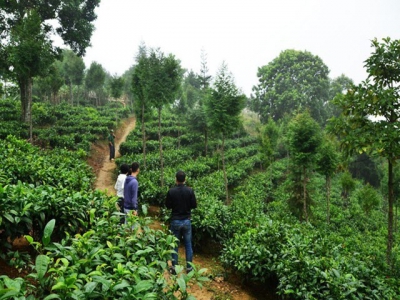Ethnic farmers grow valuable tea in remote mountains

NGHỆ AN — Shan tea, a type of wild tea tree grown by ethnic minorities, has been well known in the mountainous provinces in the north of Việt Nam for many years.
Farmers harvest Shan tea grown on the remote mountainous area of Nghệ An Province. — Photo thanhnien
But little is known about a large Shan tea area in a remote mountainous district of Nghệ An Province in central Việt Nam.
Profits from the tea have become the main source of income for local people from the H’mong ethnic group in Kỳ Sơn District.
About 15 years ago, Kỳ Sơn District was the poorest in Nghệ An Province. The ethnic minority people there grew marijuana to generate money.
A group of volunteer war veterans from the province was assigned the task of helping locals improve their livelihoods.
“We decided to grow Shan tea because of its short cultivation time and stable income that it can bring farmers,” Vương Xuân Trụ, deputy head of the group told Thanh Niên (Young People) newspaper.
Shan tea has been grown in the mountains of northern Hà Giang and Yên Bái provinces at heights of 1,200m above sea level or higher. Realising the villages in Nghệ An are at the same height, the group brought the tea seedlings to Kỳ Sơn, taught themselves how to grow, harvest and preserve the tea, before teaching local farmers.
Thanks to fluctuations between day and night temperatures and steep hills, Shan tea grows rapidly on the mountain without fertilisers.
More and more households then realised the benefits of the tea and gave up growing marijuana and switched to Shan tea.
Until now, more than 400 households in Huồi Tụ and Mường Lống communes in Kỳ Sơn District are growing the tea.
The growing area then was expanded to districts of Anh Sơn, Thanh Chương, Nghĩa Đàn and Con Cuông.
The more than 1,000 ha of Shan tea grown in Nghệ An has become one of the biggest Shan tea cultivation areas in Việt Nam. The tea has helped ethnic minority farmers get out of poverty and improve their livelihoods.
Unique taste
Phạm Đức Trình, former deputy director of Anh Sơn Tea Factory, one of the war veterans who came to Nghệ An and taught locals to grow the tea, said that Shan tea from Nghệ An and other northern provinces share similar features. But wind and fog of the mountainous weather conditions make the Nghệ An tea taste sweeter and smell better than other types.
Almost all households in H’mong villages grow Shan tea and drink the tea every day.
A common health tip among locals is to chew fresh, bitter-tasting Shan tea leaves to cure stomachaches.
Phan Thị Hồng, a local in Cao Sơn District told Thanh Niên newspaper that taking care of the Shan tea plants is simple without having to water or fertilise them.
“Each day I harvested about 50 to 60 bunches of tea, each of them sold at VNĐ7,000 (USS$0.3) for wholesale traders and VNĐ10,000 ($0.4) for retail buyers,” she said.
Nguyễn Văn An, a tea growing instructor, said that the Nghệ An Shan tea is completely free of chemicals.
Nguyễn Thị Ánh Hồng, deputy head of Việt Nam Tea Association, said that the Shan tea that is famous in northern mountainous provinces has been successfully applied in a central province like Nghệ An.
“This is a precious area of raw materials that will create products of high value to Vietnamese tea production,” she said.
Có thể bạn quan tâm
 Vietnamese mango finds 40th export market – the US
Vietnamese mango finds 40th export market – the US After 10 years of persistent negotiations, Vietnam has conquered one of the most fastidious markets to export mango, the US.
 Star apple shipment to US to increase threefolds
Star apple shipment to US to increase threefolds The Mekong Delta province of Tien Giang aims to ship 300 tonnes of star apples to the United States until the end of the 2018-2019 crop
 Vietnam reconsidering rice production, export plans
Vietnam reconsidering rice production, export plans Vietnam’s rice export turnover has been increasing year after year, but most exports continue to be raw and pre-processed products, experts say.